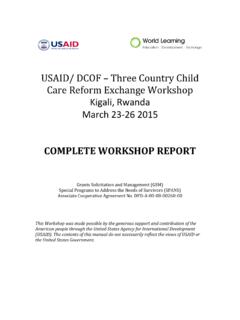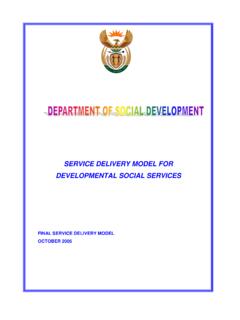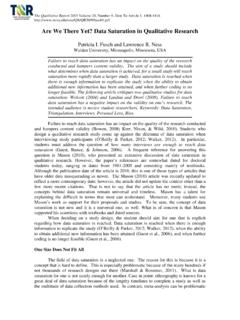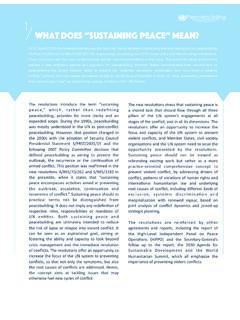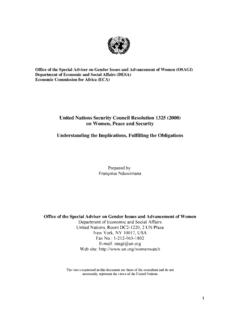Transcription of Community Treatment Programs for Juveniles: A Best ...
1 International Journal of Behavioral Consultation and Therapy Volume 2, No. 2, Spring, 2006. Community Treatment Programs for Juveniles: A Best-Evidence Summary Lee A. Underwood, Kara Sandor von Dresner & Annie L. Phillips Abstract A significant challenge facing the juvenile justice system is the task of transitioning and reintegrating juveniles from youth corrections facilities back into the Community . This challenge, in part, is related to determining whether the referred Community Programs are effective. This article summarizes the literature on the effectiveness of Community Programs for juveniles involved in the justice system, including defining characteristics of evidence-based Programs and examining the relationship between youth characteristics and evidence-based practices. Model evidence-based Programs are reviewed, providing a description of respective Programs , Treatment targets, and their outcomes. Limitations of evidence-based Programs will be discussed and recommendations for the field will be summarized.
2 Key words: Community Programs , juvenile justice, evidence-based Programs , delinquents, Treatment . Introduction The juvenile justice system is overwhelmed with the increasing number of youth who are arrested each year. In 2003 about million youth under the age of 18 were arrested and over 130,000 are placed in detention and juvenile correctional facilities (Cocozza, Trupin, &Teodosio, 2003). As a result, the number of youth who are released back into society is growing; according to the Office of Juvenile Justice and Delinquency Prevention's (OJJDP) Census of Juveniles in Residential Placement, approximately 100,000 youth are discharged from a juvenile correctional facility each year. This estimate is a modest one at best because when compared to adult offenders, juveniles actually spend less time in correctional facilities; therefore the actual percentage of juveniles returning to the Community each year is much greater (Sickmund, 2000).
3 Effective Treatment Programs are key in youth's successful reintegration back into their homes and communities. Gendreau and Goggin (1996) found that recidivism rates decreased by as much as 25 percent than those youth who did not participate in any institutional or Community program. The most effective, however, are evidence based Treatment Programs as they can reduce recidivism from 25 percent to 80 percent (Gendreau, 1996 & The National Mental Health Association [NMHA], 2006). This poses a significant challenge to the juvenile justice system for it now has the task of diverting and reintegrating some incarcerated juveniles into some kind of Treatment program. While evidence-based Community Programs are ideal, they are often underused for a variety of reasons. It is often difficult to determine what Treatment Programs are researched-based (Hoagwood, Burns, Kiser, Ringeisen and Schoenwald, 2001). Once this is done, the characteristics of a program must be complimentary or tailored to juveniles and their presenting problems.
4 This involves properly identifying the youth who are appropriate for program and linking with Community resources. Another challenge that prevents the implementation of model Programs is the interchangeable terms that are used in identifying research-based Programs and the various definitions these terms hold. Juvenile justice systems must establish a universal language. Frequently used terms when discussing post- release Programs include evidence-based, best practice, research-based and innovative practice. It is critical to exam the similarities and the differences of these types of Treatment so that juvenile justice officials can choose evidence-based Programs that are complimentary with the specialized needs of each juvenile in the juvenile justice system. Using a common language also helps researchers to further examine the unique characteristics of evidence-based Programs (Burns, Hoagwood and Mrazek, 1999 &.)
5 Beale & Jones-Walker, 2004). 286. International Journal of Behavioral Consultation and Therapy Volume 2, No. 2, Spring, 2006. Researchers endorse the idea that evidence-based Programs in Community settings are more effective than those in residential or institutional settings; however, further examination on the effectiveness of these Programs is warranted (Altschuler & Armstrong 2002; Burns, et al., 1999 &. Steiner, Dunne, Ayres, Arnold, Benedek, Benson, Bernstein, Bernet, Bukstein, Kinlan, Leonard &. McClennan, 1997; Underwood, Barretti, Storms & Safonte-Strumbolo, 2004; Wood, Trupin, Turner, &. Vander Stoep, 1999). This article summarizes existing knowledge about evidenced based Programs so that researchers, clinicians, and juvenile justice program administrators can choose interventions that are proven to lower recidivism rates. Evidence-based definitional criteria and its characteristics, efficacy and effectiveness will be defined.
6 The importance of implementing or developing evidence-based Programs to cater to the unique issues that juveniles bring is highlighted in the relationship between youth characteristics and Treatment Programs . Model evidence-based Community Programs are identified with a description of each. Limitations of evidence-based Programs will conclude this article. What is Evidence-Based Practice? Defining Evidenced-Based Practices There are a variety of definitions for evidence-based practices utilized throughout the fields of juvenile justice and mental health. The National Institute of Mental (2001) and Hoagwood (2003) define evidence-based as a body of knowledge, obtained through scientific method, on the prevalence, the incidence, the risk for mental disorders, and the impact of Treatment and services on mental health related issues. In the juvenile justice field, the term evidence-based is defined as a body of knowledge, also obtained through scientific method, on the impact of specific practices on targeted outcomes for youth and their families (Hoagwood, et.)
7 Al, 2001). McDonald (2003) conceptualized that evidence-based Programs consists of three characteristics (defined outcomes, measurable outcomes, and practical realities or the rate of recidivism). The Interdisciplinary Committee on Evidence-based Mental Health Care mandated definitional criteria for evidence-based practice (Weisz, 2001). The committee states that in order for Treatment to be determined evidence-based, it must have at least two between group design studies representing the same age group and receiving the same Treatment for the same target problem. The National Institute of Mental Health (NIMH) developed a list of research procedures that are consistent with evidence-based practices. These include: 1. Minimum of two control group studies or a large series of single-case design studies. 2. At least two researchers. 3. Utilization of a Treatment manual. 4. Therapist training and guidelines. 5. Accurate clinical samples of youth.
8 6. Clinical significant tests of outcomes. 7. Reviewed functioning and symptom outcomes. 8. Long-term effects after release (Burns 1999). 9. Two or more studies that are superior to medication, placebo or an alternative Treatment that is equivalent to an established Treatment . Clearly understanding the definitional criteria related to evidence-based practices allows practitioners to determine which interventions will be more effective in treating youth (Virginia Youth Commission, 2004). 287. International Journal of Behavioral Consultation and Therapy Volume 2, No. 2, Spring, 2006. Determining Effectiveness The terms effectiveness and efficacy are often confused. Effectiveness refers to the validity of the intervention when applied in clinical circumstances, whereas efficacy refers to the validity of the intervention under controlled research conditions (Lehman, Godman, Dixon, & Churchill, 2004). Hoagwood et. al., (2001) suggest that in order for a Treatment protocol to be efficacious, two or more studies must show it to be superior to a control condition, one or more experiment must meet the criteria for a well designed Treatment , or three single case studies must be conducted.
9 Other indicators of effective Programs share characteristics: 1. Reliance upon an empirically validated theory, which addresses the reduction of risk factors. 2. Trained providers with clinical supervisors, who maintain the integrity of the program design. 3. Training/program manuals that are available to all staff members. 4. Validated risk assessments to classify offenders and determine their criminogenic factors. 5. Use of cognitive behavior interventions. 6. Follow-up interviews with youth and their families, which are structured components of the program (Andrews, Bonta & Hoge, 1990; Gendreau &. Goggin, 1995). Evidence-based practices should focus on the outcome. Joplin, Bogue, Campbell, Carey, Clawson, Faust, Florio, Wasson, and Woodward (2004) stated that interventions within corrections are considered effective when they reduce offender risk and subsequent recidivism (p. 3). Evidence-based practice relies on the following principles: 1.
10 Assessment of actuarial risks/needs. -An ongoing assessment of youths' psychosocial and risk for delinquency needs should be conducted to determine the level of supervision and the types of services needed (Clements, 1996). 2. Enhancement of intrinsic motivation. -Providers should relate to offenders in order to elicit change (Miller & Rollnick, 2002). Use of motivational interviewing and engagement strategies are helpful in developing rapport and effective relationships. 3. Objective interventions. -Risk principle: Prioritize supervision and Treatment resources for higher risk offenders. -Need principle: Target interventions to criminogenic needs. -Responsivity Principle: Be responsive to temperament, learning style, level of motivation, culture, and gender when assigning Programs and interventions. -Dosage: Structure 40-70% of high-risk offenders' time for at least 288. International Journal of Behavioral Consultation and Therapy Volume 2, No.










